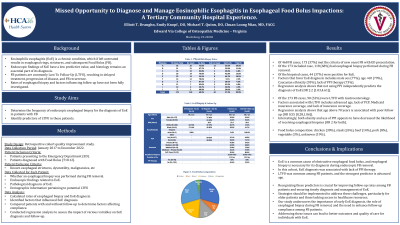Monday Poster Session
Category: Esophagus
P1851 - Missed Opportunity to Diagnose and Manage Eosinophilic Esophagitis in Esophageal Food Bolus Impactions: A Tertiary Community Hospital Experience
Monday, October 23, 2023
10:30 AM - 4:15 PM PT
Location: Exhibit Hall

Has Audio

Elliott Draughn
Edward Via College of Osteopathic Medicine
Roanoke, Virginia
Presenting Author(s)
Elliott Draughn, 1, Emily Knopf, DO2, Chuan Long Miao, MD, FACG3, Michael Quinn, DO3
1Edward Via College of Osteopathic Medicine, Roanoke, VA; 2Virginia Tech Carilion, Roanoke, VA; 3Lewis Gale Medical Center, Roanoke, VA
Introduction: Eosinophilic esophagitis (EoE) is a chronic condition, which if left untreated results in esophageal rings, strictures, and subsequent Food Bolus (FB). Endoscopic findings of EoE have a low predictive value, and histology remains an essential part of its diagnosis. FB patients are commonly Lost To Follow Up (LTFU), resulting in delayed treatment, progression of disease, and FB recurrence. Rates of esophageal biopsy and factors influencing follow up have not been fully investigated.
Methods: In this retrospective cohort quality improvement study, we gathered data from patients with an Emergency Department (ED) presentation and a diagnosis of Food Bolus (T18.12) within a six-year time window (1/2017-12/2022). The performance of an esophageal biopsy, endoscopic findings of EoE, and pathological diagnosis of EoE were recorded for each patient. Rates of biopsy and diagnosis were calculated, and patients with and without follow-up were compared using general demographic and clinical data for potential factors influencing follow up compliance.
Results: Of 468 FB cases, 173 (37%) met the criteria of new onset FB with ED presentation. Of the 173 included case, 118 (68%) had esophageal biopsy performed during FB removal. Of the biopsied cases, 44 (37%) were positive for EoE. Factors that favor EoE diagnosis includes male sex (77%), age < 60 (79%), Caucasian ethnicity (93%), lack of PPI therapy (73%). Regression analysis shows that not using PPI independently predicts the diagnosis of EoE (OR 2.2 [1.03,4.61]). Of the 173 FB cases, 90 (52%) were LTFU with Gastroenterology. Factors associated with LTFU includes advanced age, lack of PCP, Medicaid insurance coverage, and lack of insurance coverage. Regression analysis shows that age above 70 years is associated with poor followup (OR 0.55 [0.28,1.06]). Interestingly, both obesity and use of PPI appears to have decreased the likelihood of undergoing esophageal biopsies (OR 2 for both).
Discussion: EoE is a common cause of obstructive esophageal food bolus, and esophageal biopsy is necessary for its diagnosis during endoscopic FB removal. In this cohort, EoE diagnosis was associated with lack of PPI therapy. LTFU was common among FB patients, and the strongest predictor is advanced age. Recognition of these predictors and strategies should be implemented to improve FB patient follow up.
Disclosures:
Elliott Draughn, 1, Emily Knopf, DO2, Chuan Long Miao, MD, FACG3, Michael Quinn, DO3. P1851 - Missed Opportunity to Diagnose and Manage Eosinophilic Esophagitis in Esophageal Food Bolus Impactions: A Tertiary Community Hospital Experience, ACG 2023 Annual Scientific Meeting Abstracts. Vancouver, BC, Canada: American College of Gastroenterology.
1Edward Via College of Osteopathic Medicine, Roanoke, VA; 2Virginia Tech Carilion, Roanoke, VA; 3Lewis Gale Medical Center, Roanoke, VA
Introduction: Eosinophilic esophagitis (EoE) is a chronic condition, which if left untreated results in esophageal rings, strictures, and subsequent Food Bolus (FB). Endoscopic findings of EoE have a low predictive value, and histology remains an essential part of its diagnosis. FB patients are commonly Lost To Follow Up (LTFU), resulting in delayed treatment, progression of disease, and FB recurrence. Rates of esophageal biopsy and factors influencing follow up have not been fully investigated.
Methods: In this retrospective cohort quality improvement study, we gathered data from patients with an Emergency Department (ED) presentation and a diagnosis of Food Bolus (T18.12) within a six-year time window (1/2017-12/2022). The performance of an esophageal biopsy, endoscopic findings of EoE, and pathological diagnosis of EoE were recorded for each patient. Rates of biopsy and diagnosis were calculated, and patients with and without follow-up were compared using general demographic and clinical data for potential factors influencing follow up compliance.
Results: Of 468 FB cases, 173 (37%) met the criteria of new onset FB with ED presentation. Of the 173 included case, 118 (68%) had esophageal biopsy performed during FB removal. Of the biopsied cases, 44 (37%) were positive for EoE. Factors that favor EoE diagnosis includes male sex (77%), age < 60 (79%), Caucasian ethnicity (93%), lack of PPI therapy (73%). Regression analysis shows that not using PPI independently predicts the diagnosis of EoE (OR 2.2 [1.03,4.61]). Of the 173 FB cases, 90 (52%) were LTFU with Gastroenterology. Factors associated with LTFU includes advanced age, lack of PCP, Medicaid insurance coverage, and lack of insurance coverage. Regression analysis shows that age above 70 years is associated with poor followup (OR 0.55 [0.28,1.06]). Interestingly, both obesity and use of PPI appears to have decreased the likelihood of undergoing esophageal biopsies (OR 2 for both).
Discussion: EoE is a common cause of obstructive esophageal food bolus, and esophageal biopsy is necessary for its diagnosis during endoscopic FB removal. In this cohort, EoE diagnosis was associated with lack of PPI therapy. LTFU was common among FB patients, and the strongest predictor is advanced age. Recognition of these predictors and strategies should be implemented to improve FB patient follow up.
Disclosures:
Elliott Draughn indicated no relevant financial relationships.
Emily Knopf indicated no relevant financial relationships.
Chuan Long Miao indicated no relevant financial relationships.
Michael Quinn indicated no relevant financial relationships.
Elliott Draughn, 1, Emily Knopf, DO2, Chuan Long Miao, MD, FACG3, Michael Quinn, DO3. P1851 - Missed Opportunity to Diagnose and Manage Eosinophilic Esophagitis in Esophageal Food Bolus Impactions: A Tertiary Community Hospital Experience, ACG 2023 Annual Scientific Meeting Abstracts. Vancouver, BC, Canada: American College of Gastroenterology.
